Hello everybody, Maniac4Games is the place for all kinds of video game topics and even sharing my opinions. This article was submitted for The Odyssey on April 11, 2016, and since then I still feel these opinions about each Toys-To-Life franchise, even as the genre starts to fade away. Since this article, more figures have been made for each category. Enjoy!
[Original article published here: https://www.theodysseyonline.com/what-is-toys-to-life-gaming-and-who-does-it-best]

(3 Franchises, 3 Mascots, but only 1 will rise above the rest for interactive play.)
What Is Toys-To-Life Gaming, And Who Does It Best?
“Even though you’re not moving, you feel like you’re alive” — Jesse from ‘Toy Story 2’
After the release of “Skylanders,” the Toys-to-Life genre of gaming was not only born, but also popular with kid and young adult gamers. This type of gaming offers a more interactive experience with adding and customizing the characters you play within the game, and even altering the world inside the game itself. Today I will focus on three of the Toys-To-Life franchises that followed “Skylanders”‘ success: Disney Infinity, LEGO Dimensions and Nintendo Amiibo. Each have unique aspects that expand what the technology is capable of bringing to gamers. We will learn more about Toys-to-Life through these concepts as well.
Contents
Toys-to-Life gaming essentially has three components: the interactive figures, which offer extra gameplay features and characters for players to play with; the gamepad, on which the interactive figures connect in the game; and the additional game pieces, which enhance abilities of the interactive figures or change the environment in the game.
Starting off with Disney Infinity, we can see the largest variety of contents used for the franchise.
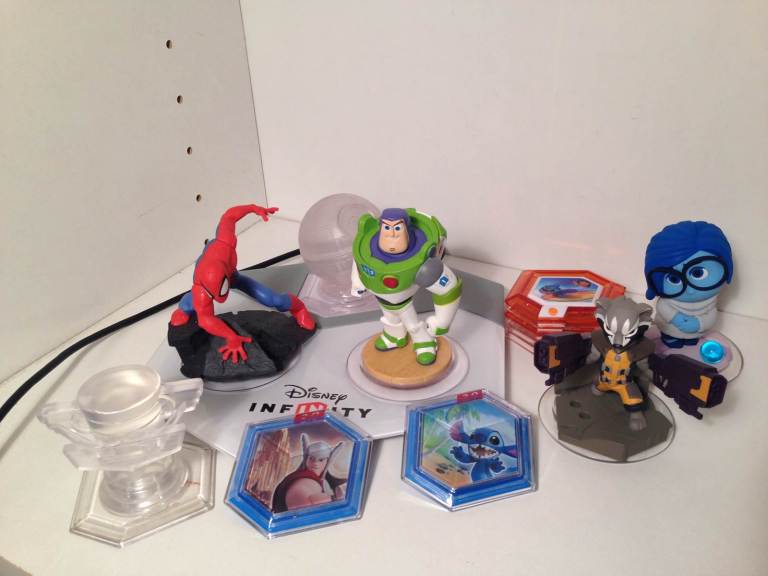
In this photo we can see various characters from Disney properties, including Marvel and Pixar animations. There’s even “Star Wars” features and live-action Disney films represented in this game series. The Game Pieces vary from Play Sets, which provide a campaign mode for players to use characters with, and Power Discs, which equip characters with new weapons, vehicles or settings based on Disney properties.
The Play Sets started in 1.0 as clear pieces (“Cars” and “Star Wars” shown), then moved to small blue discs closely resembling the Power Discs (Thor and Stitch shown). Power Discs are generally clear with images of what each one offers, but orange ones are marked as rare. Power Discs are sold in blind packages and only by the bar code can you tell them apart. Interactive figures are often packaged with other figures and Play Sets, but can be bought separately for most of the figures.
Up next, things become more simple with LEGO Dimensions.
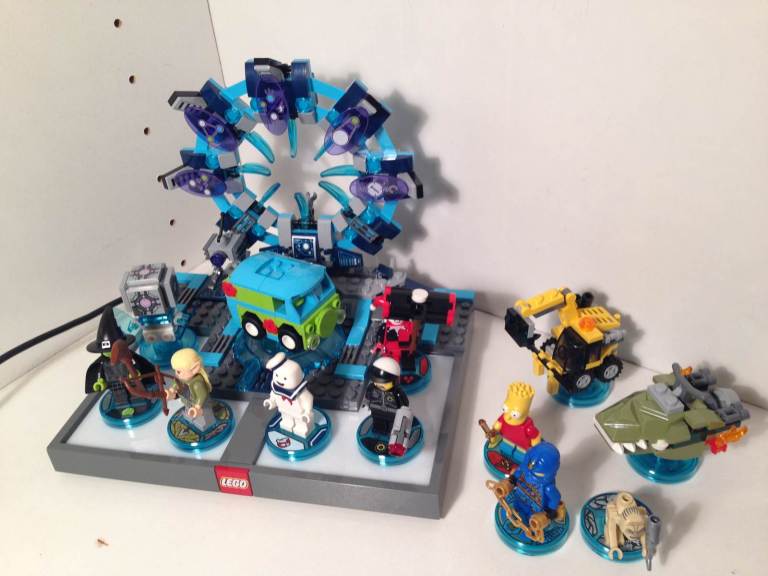
There are three components in LEGO Dimensions: mini-figures as interactive figures, vehicles and objects as Game Pieces (known in game as gadgets) and the portal as the Gamepad. The mini-figures offer various features like X-Ray vision, stealth, cutting through gold bricks, flying and many more. But if you can’t afford all of these figures, the gadgets offer some of the features through a system of upgrades (Benny’s Spaceship can cut through gold bricks and fly even if Benny can’t). The gamepad offers a build-able portal to tie into the story of mini-figures from various worlds travelling through time and space into each other’s worlds (unlike Disney Infinity, which doesn’t explain why the figures cross over worlds).
Third, things get very simple for Nintendo Amiibo.
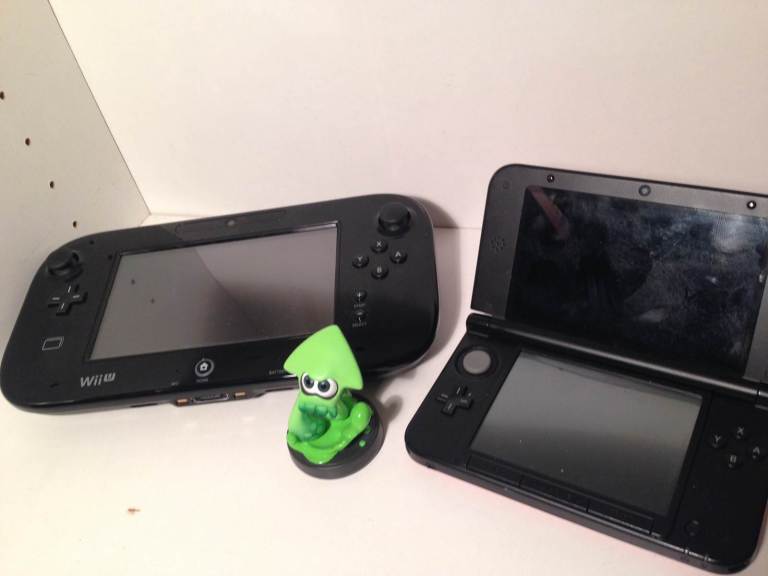
Well, that’s very simple. There’s the gamepad and the interactive figure. There are Amiibo Cards for the Animal Crossing games but they are treated more like Amiibo than Game Pieces. Nintendo Amiibo stand out from most Toys-to-Life experiences in that the interactive figures (Amiibo) are not made for a single game, but rather various Nintendo-licensed games from the WiiU and 3DS XL (or 3DS with a separately sold accessory). The Gamepad for each of them doesn’t require that they stay in one place; just tap them and they’ll appear in the game. Well, more like features from them, as you don’t normally play as the Amiibo you use. Think of the Amiibo like DLC: you can play games like “Mario Kart 8” or “Super Smash Bros.” without them, but they add extra unlockables to give you more to play with.
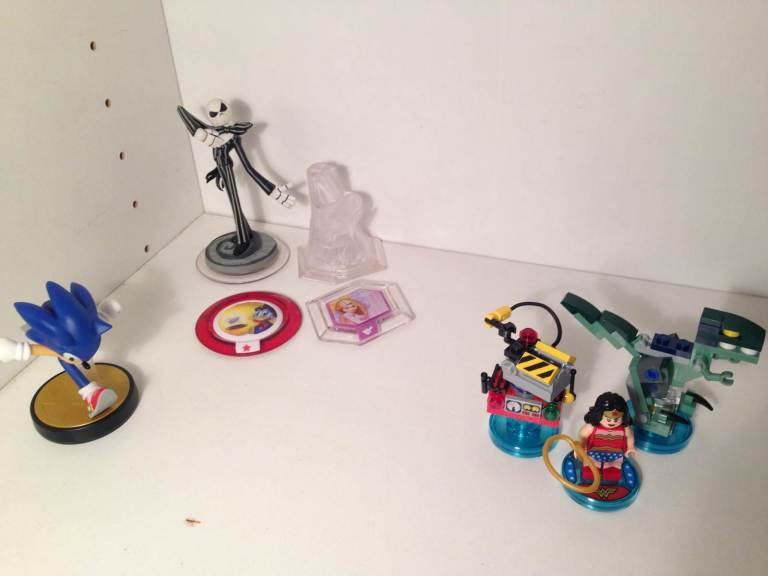
Variety
Disney Infinity and Nintendo Amiibo are similar in their character choices — they exist from their library of intellectual properties.
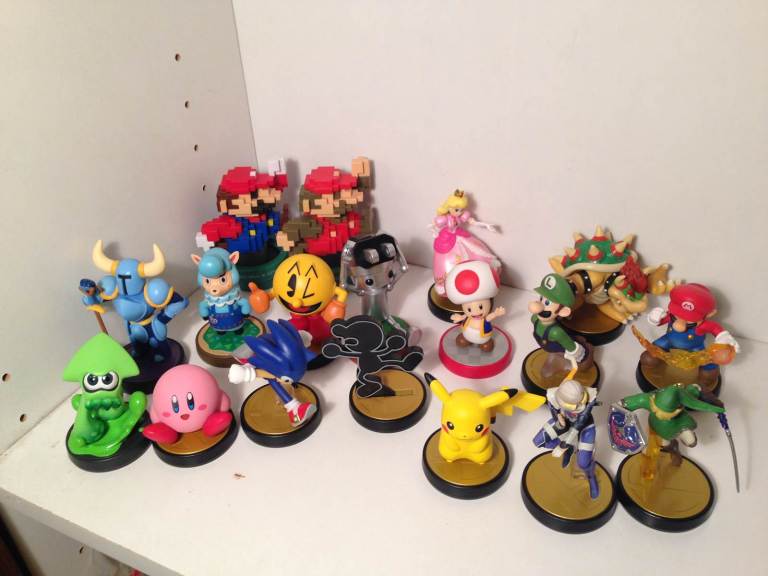
Nintendo Amiibo have figures from “Super Mario,” “Pokemon,” “Legend of Zelda” and “Animal Crossing,” but have also reached for Namco (“Pac-Man”), Sega (“Sonic”) and even Yacht Club Games (“Shovel Knight”) for collectible figures. Very few of the figures are exclusive to one game, like the three “Splatoon” Amiibo and “Shovel Knight” for the self-titled game. Many of the others seen here and elsewhere can be used across multiple games on both Nintendo WiiU and 3DS XL.
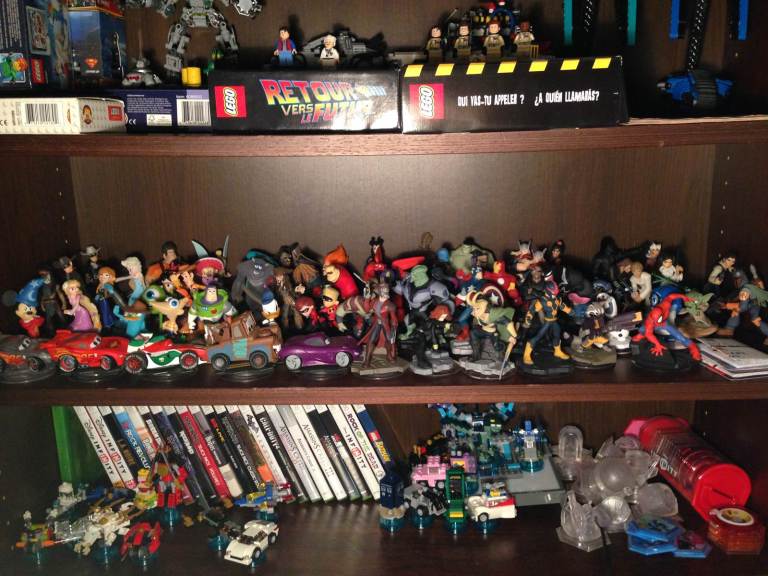
Disney Infinity has the widest selection of characters, which means I needed to show them on an entirely different shelf, among my other video games (LEGO Dimensions gadgets seen at bottom too). Disney Infinity has expanded from classic to Pixar animated to Marvel to “Star Wars.”
Where next? Who knows? But this offers lots of lovable characters to play through all the games — if you’re playing on 3.0 and beyond. If you use early versions of the game series, you have a more limited library than what is shown here. Left to right gives you an idea of who is used in each progressing version of Disney Infinity. Marvel was introduced in 2.0, and “Star Wars” in 3.0.
The characters are free to use in the Toy Box mode, in which you create your own playable world from scratch, but in Play Sets you’re limited by the film franchise used. For example, “Star Wars” Play Sets allow you to play with only “Star Wars” characters. So you can’t play with Spider-man in a Monsters’ University campaign for two reasons. Too bad; I think he might fit in well.
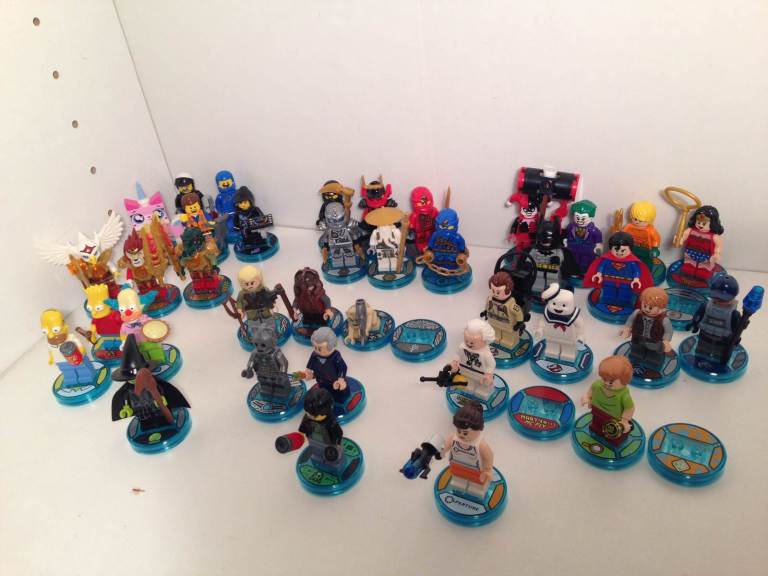
These are all of the playable mini-figures in LEGO Dimensions (some are removed from their bases; we’ll talk about that later). Counting in gadgets, there’s double the number of playable pieces in game, and it has no compatibility issues since this is the first version of LEGO Dimensions (with more figures like Bane and Slimer coming soon, as well as future versions).
LEGO Dimensions offers the most diverse of characters, as few of these are directly LEGO-owned. Most are licenses with “Doctor Who,” “Portal,” “Scooby-Doo,” “Back to the Future,” “Ghostbusters,” “Midway Arcade,” “Wizard of Oz,” “Lord of the Rings,” “The Simpsons,” “Jurassic World” and “DC Super Heroes” (since this game was made with Warner Bros. and Disney has Marvel in their own games).
The only ones LEGO owns are “The LEGO Movie,” “Legends of Chima” and “Ninjago.” In game the characters are voiced well by original actors (Christopher Lloyd and Matthew Broderick reprise their BTTF roles) as well as some previously used lines (“Ghostbusters” and “The Simpsons”), and even mixes of the two with impersonated voice actors (“Scooby Doo” and “DC Super Heroes”).
The new lines offer more interaction in game, such as Batman calling Krusty the “wrong clown” in reference to the Joker, or the Wicked Witch naming Wonder Woman a “good witch.” It embraces the weird mash-up of characters very well, and the abilities of these characters are well suited for their movie and TV show roles.
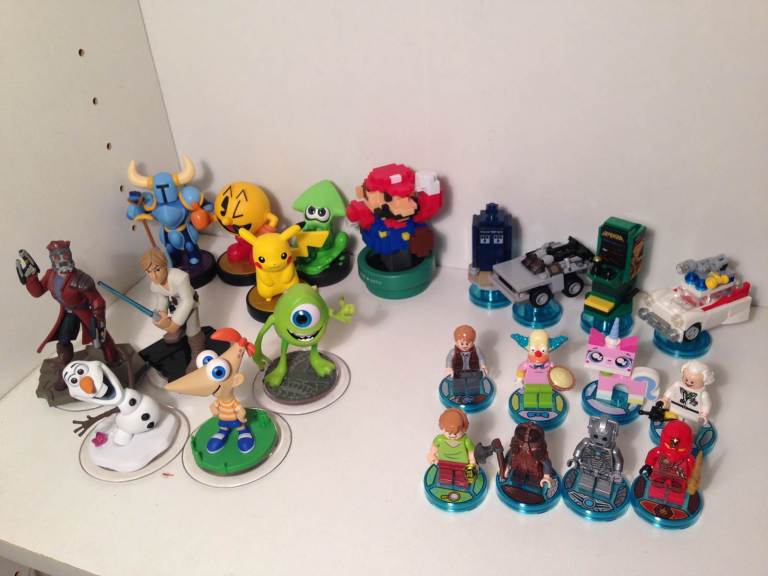
Which do I prefer?
To sum things up, Nintendo Amiibo is the least varied in terms of playability and variety. I don’t have all of the Amiibo, but I don’t see much diversity, as a majority of them are either “Pokemon,” “Animal Crossing” or “Super Mario” characters, with a few shining in between. They will sit the most on your shelf during gameplay as they are only tapped into the game but not resting with the gamepad, and don’t demand switching for other characters. In fact, in “Super Mario Maker,” you don’t need the Amiibo outside the 8-Bit versions of Mario to access their special mushroom costumes in the game.
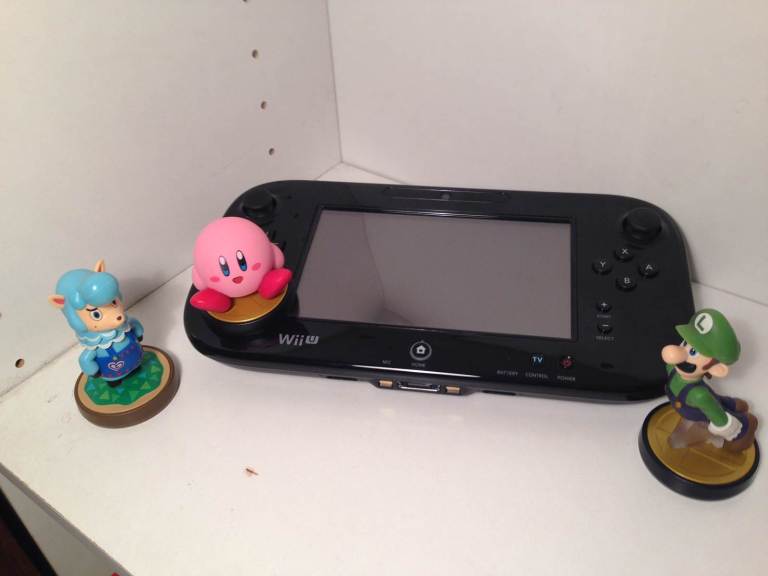
Disney Infinity offers more use of the characters in game, as long as they sit on the game pad. But there are limits on playing with them in Play Sets, as well as playing in each version of the game. The game versions are not backward compatible with Play Sets, which makes play even more limited. If you have Disney Infinity 3.0 and want to play in the “Toy Story” levels, you’ll need Disney Infinity 1.0 as well as any of the “Toy Story” characters like Buzz or Woody. It encourages buying the games and figures to such a massive collection in order to play with everything possible in every game possible.

LEGO Dimensions may be the latest entry into the Toys-to-Life genre, but it certainly did its homework against the competitors. In LEGO Dimensions you can play with any mini-figure in any world equivalent to Disney Infinity’s Play Set pieces (e.g., Doc Brown running around Aperture Science from “Portal,” or Unikitty exploring the world of “Scooby-Doo”). The possibilities are endless for combinations, and on top of that, this Toys-to-Life game actually uses toys outside of the game! The following picture shows how you can customize the Toys-to-Life figures from all three franchises in this article.
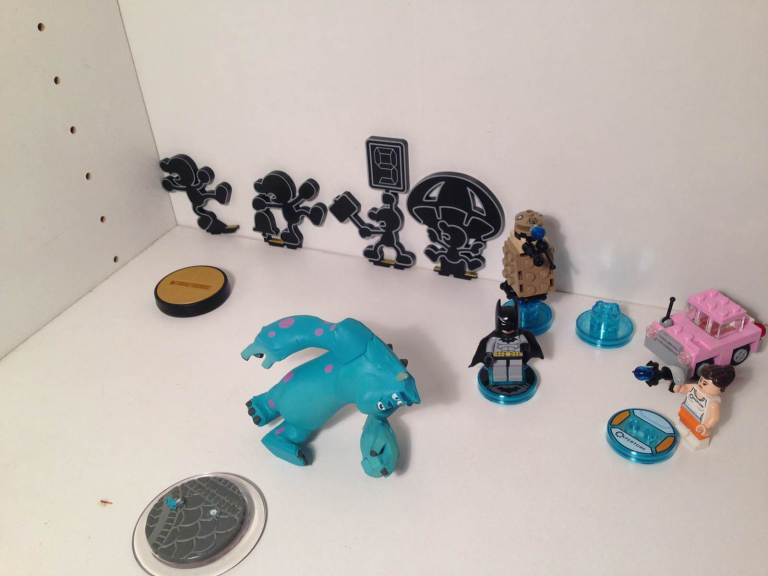
The Batman on the base is not the one from the Starter Pack, but rather a regular figure from a LEGO set back in 2006. The base is all you need for any of the pieces to be played in game, including the gadgets (you can roll Homer’s car off the game). However, LEGO Dimensions encourages them to be on the bases while playing the game, as you switch figures out constantly in game. This keeps the interactive figures interesting and keeps the player more engaged with the base.
In some points of the game, you have to move figures on separate parts of the base to avoid obstacles, solve puzzles or activate special areas (e.g., the hacking minigame used with Benny or the Doctor). The gadget bases can also be rewritten, so all of the gadget progress is saved on the character bases (Chell has the data for the Sentry and Companion Cube gadgets). That means if you had a second player, you can share the same gadgets with both players (I tried having two Deloreans from “Back the Future”).
The gadgets also have options for upgrading, customizing colors and styles and various abilities in case you didn’t have the figures. You don’t need every interactive figure or game piece to play the game; in fact, all you need to play the campaign is included in the Starter Pack.
Now let’s look at the other two. Nintendo Amiibo are fixed to their bases, except Mr. Game and Watch, who has a gimmick of changing his pose from various handheld games. And Disney Infinity? Well, that was an accident to poor Sulley, and it still plays base alone, but again the figures are fixed to the bases and are either in the game or on the shelf.
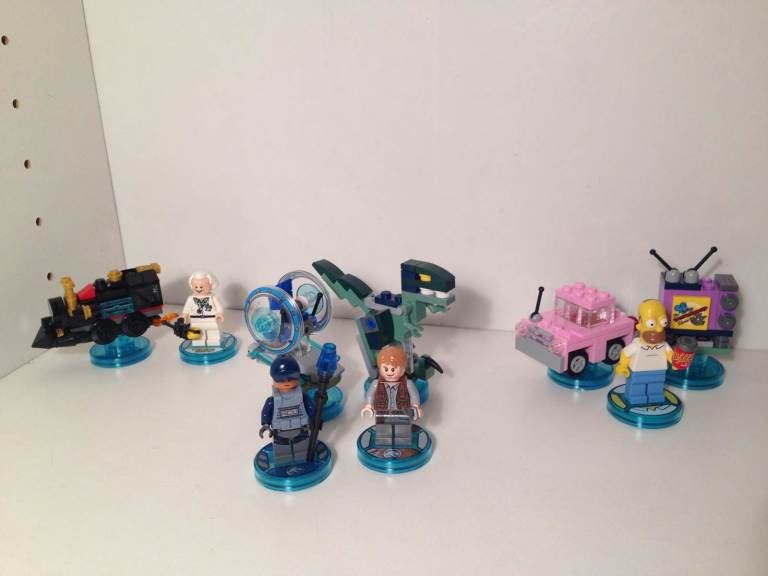
My personal favorite is LEGO Dimensions, as it took the gameplay of the other two games, as well as “Skylanders” for customizable figure on top of the base, and enhanced them all at once. The Toys-to-Life genre is more expanded upon with each new game franchise, and I’m excited to see what more can be done with interactive figures.
Which did you like best? Let me know in the comments. I would have mentioned more about “Skylanders,” as it was the pioneer of this genre, but I do not own it and cannot speak about it personally.